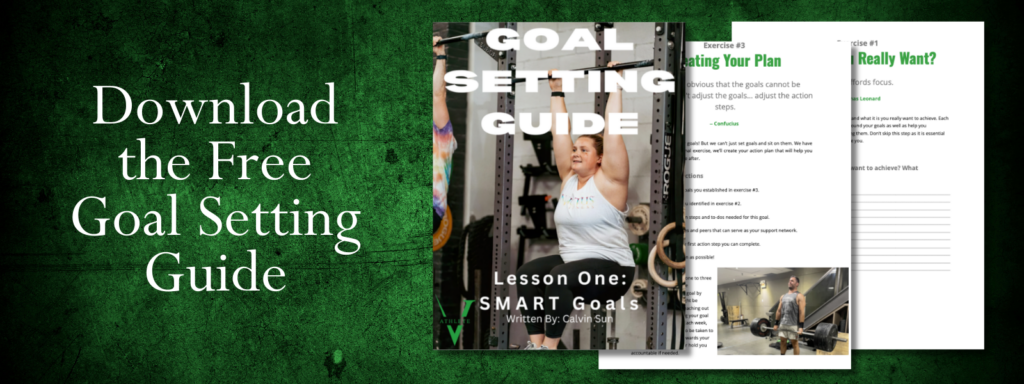
Mini-Milestones in Goal Setting
Written by Justin Wright
If you have been following along with this “goal-setting series” thus far, then chances are you now have a better understanding of how to set goals which are specific, measurable, actionable, relevant and time-bound. My hope is that you have also set goals which will challenge you and make you uncomfortable on the path to achieving them. True growth can only occur through discomfort, and sometimes it is very uncomfortable to dream big!
That said, this discomfort can also be negative if it prevents you from making tangible steps towards your larger goals. A critical skill that is often neglected in goal setting is how to break down the larger, big-ticket goals into smaller, more manageable pieces. You must build a wall brick by brick, and accomplishing daunting tasks is no different.
Creating Your Stepping Stones
The most effective way to achieve long-term goals is to build positive momentum en route to those goals. By accomplishing a series of smaller, more manageable tasks, you will build confidence and gain valuable perspective. What once seemed like a daunting, impossible task now seems slightly more achievable. Combine this with the fact that success begets success: the more small boxes you can check off on your journey, the more likely you are to continue checking boxes in the future!
When I work with clients on goal setting, I tell them to think of their goals in terms of three distinct categories:
Long-Term: these are your grand visions or seemingly-impossible goals. Think big! The sky is truly the limit, and this is where you can let your mind wander and envision the best version of yourself in the future.
Mid-Term: these are your stepping stones. This is where the momentum is built and where you can experience the satisfaction of smaller successes. The more of these items you can accomplish, the closer you will get to your long-term goals.
Short-Term/Daily Tasks: I believe that this is where the magic happens. These are the things you must do every day and every week in order to work through your stepping stones. These tasks are where accountability and discipline are developed. When people talk about the “grind” and the “hustle,” these are the things they are referring to.
How do you create this list for yourself?
We will get more into how to develop discipline and continue building momentum using your daily task list in an upcoming article. For now, understand that these three lists help you create a plan of action, or a roadmap, for getting from Point A to Point B. If you follow the SMART principles we discussed, then chances are you will be able to create a series of intelligent goals that are achievable and measurable. Without action, your goals just become another list of words. Working towards them gives this list meaning.
You must convince yourself that your goals are actually attainable. This is where your mid-term and short-term goals come into play. As the entrepreneur Greg Reid once said, “A dream written down with a date becomes a goal. A goal broken down into steps becomes a plan. A plan backed by action makes your dreams come true.”
Looking at a few specific examples might help you make more sense of this concept. Let’s analyze an immense goal in three different categories, and show how that goal can be broken down into both mid-term goals and daily tasks.
Nutrition & Body Composition Goals
In 2019, you decide that you want to lose 30 pounds and attain a body fat percentage of 10 percent. This is a tremendous goal, but how often do New Year’s Resolutions look and sound exactly like this?
“This will be the year I finally get in shape.”
“This year I will look the best I have ever looked.”
“This is the year I finally get a six-pack.”
There is absolutely nothing wrong with having a lofty goal like this. The problem is that, unless broken down into smaller pieces, most people inevitably lose motivation and fall short of these goals. It isn’t because they are weak-minded, or incapable of success, but more because they have taken the wrong approach. So what must happen on the way to that long-term goal? What are the stepping stones?
1. Eliminate defined “cheat foods” from diet except for one day each week
2. Reduce alcohol intake from 5 days weekly to 2 days
3. Lose 10 total pounds
4. Lose 20 total pounds
5. Lose 30 total pounds
6. Attain 16 percent body fat
7. Attain 10 percent body fat
There are many more intermediate, mid-term goals that can be created, but the idea is that you are creating smaller and more manageable milestones. From there, the required daily task list would be built around this list of mid-term goals:
1. Consume 1 gallon of water daily
2. Get 7 hours of sleep nightly
3. Have healthy food prepared for all meals during the week
4. Avoid alcohol except on predetermined days
5. Avoid sugar consumption
6. Exercise 4 days each week
As you can see, the daily task list is what actually allows for progress on your mid-term goals. One cannot function without the other! The daily tasks allow for measurable progress to be made consistently. You are either completing your tasks or you aren’t, and this rate of completion directly correlates with your likelihood of long-term success.
So what about other situations? Can this same model be applied in other areas of life, when describing other goals?
Fitness Goals
Let’s say you decide that you want to qualify for the CrossFit Games this year. Just like our nutrition example, this goal is difficult to accomplish and requires a lot of moving pieces to properly fall into place. This goal will seem much more attainable if you can break it down into a series of mid-term stepping stones:
1. Attain 20+ unbroken muscle-ups
2. Increase snatch to 275+
3. Increase clean and jerk to 350+
4. Reduce 2k row to 6:40 or less
5. Qualify for Wodapalooza Elite division
6. Place Top 3 at Wodapalooza
7. Qualify for Granite Games Elite division
8. Win Granite Games Individual
This is one possible route towards ultimately qualifying for the CrossFit Games via the new format. By checking off a series of fitness benchmarks (of which there are obviously many more required), and qualifying for a series of sanctioned events, the path towards the long-term goal of qualifying for the Games becomes much more apparent. It can be difficult to visualize this path until you take the time to map it out and accurately define it for yourself. In order to accomplish the above, mid-term tasks, your daily task list would look like the following:
1. Get 8+ hours of sleep at night
2. Ensure meals are prepped and ready to fit nutrition plan
3. Complete all programming prescribed by coach
4. 30+ minutes of mobility daily
5. Practice lagging skills 45+ minutes each week
6. Compete against others in training 3+ days each week
7. Weekly PT/massage appointment
This is just a small snapshot of the daily and weekly tasks required for a high-level athlete to ultimately be successful, particularly if their goal is to qualify for the CrossFit Games. Keep in mind, the goals you are defining are based on things that are in your control! You are not setting goals in relation to external factors such as other competitors, events that are programmed in a competition, etc. Focus on what you can control, and only build goals around things that you can directly affect positively or negatively.
What about situations that have nothing to do with health, wellness, fitness or nutrition? Does this method also work for general life goals relating to business, relationships and friendships?
Career Goals
Thus far, we have seen how effective creating mid-term goals and daily tasks can be with fitness- or nutrition-related goals. The good news is, this method works equally well when it comes to professional career goals. Let’s say that you want to grow your business to 7-figures in revenue by the end of 2019. How would your mid-term goals look if you are currently operating at 6-figures in revenue?
1. Increase production from 100 units monthly to 1,000 units monthly
2. Triple advertising budget
3. Reduce monthly expenses by 10 percent
4. Hire 10 additional employees to aid in production
5. Split-test Facebook ads to increase conversion rate by 10 percent
6. Increase revenue to 500,000 dollars
7. Increase revenue to 750,000 dollars
8. Increase revenue to 1,000,000 dollars
Without breaking these things down and creating a plan of action, how likely are you to actually grow your business? Imagine how much harder it is to drive somewhere when you don’t have directions. You would drastically reduce your travel time if you could simply fire up your GPS; think of these mid-term goals as your success GPS!
In order to accomplish the milestones above, your daily task list must build momentum towards these milestones:
1. Wake up by 5 a.m. daily
2. Respond to all client emails by 7 a.m.
3. Meet with employees and monitor production by 8 a.m.
4. Review advertising statistics daily to optimize marketing strategy
5. Monitor daily production numbers
6. Interview new employees weekly to determine qualified candidates
7. Follow-up daily with those who did not become repeat customers
8. Send daily emails to mailing list
All of these tasks, while small in their own right, ultimately lead to noticeable progress when performed regularly over time. They are not necessarily impressive feats at first glance, but their regular completion allows you to take tangible steps towards the bigger goals you have set out for yourself.
Create your lists, and get to work!
Regardless of what type of goal you have set out for yourself, realize that you must break that goal down into smaller, bite-sized chunks to maximize your likelihood of success. Don’t ever be afraid to think big when defining what you want to accomplish! Just don’t allow yourself to create a grand vision without mapping out a path that ultimately leads to that vision. Remember: a wall is built brick by brick! Define your bricks, lay them intently every day and every week. Over time, that wall will ultimately be finished, and feats that once seemed unattainable will be another check mark in your list of accomplishments.

Remember a wall is built brick by brick.
Remember , what you put in your body , Effects your brain.
im trying to better my my body,for my health and my illnessas well.i cant let my disabled body go to wasted i need to take control right now,this goal-setting series is a mind changer, i set set goals specific on the way i eat and what i eat and how i eat. protein, carbs, it all comes down to critical skills that is offen nealected.my goals are to get this weight down and keep it down.
goal
well not only can you start a new, you can access more lead way into goals and achieving higher than before. Thats what success is in the end. Did you make it on your own, or did it take extra effort to set a well balanced life.